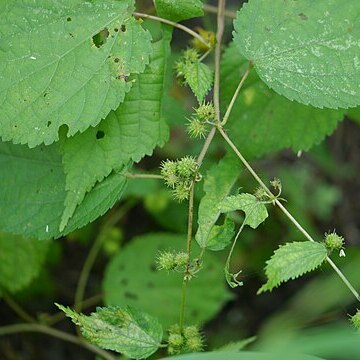Annual or short-lived perennial (0.3–)0.6–1(–2) m tall; stems solitary, yellowish, 1.5–2.5(–4) mm wide, at first densely covered in crisped hairs ± confined to 1–2 longitudinal lines, becoming glossy at length, occasionally with prickles at the base.. Leaves shortly ovate to elliptic, rarely slightly 3-lobed, (1.3–)3–9.5(–11.5) cm long, (1.1–)2–6 cm wide, apex acute to acuminate, base slightly cordate to obtuse, lacking conspicuous glands, margin coarsely serrate-crenate, membranous, subscabrid to glabrous, hairs simple; petiole (8–)18–35(–45) mm long, usually hairy as the stem, on upper surface only; stipules linear, 4.5 mm long, 0.5 mm wide, slightly hairy.. Inflorescences axillary, from uppermost nodes of the stem, internodes ± 50 mm long, cymes 3–7 at each node, subopposite the leaf, 3-flowered; peduncles 2–3(–6) mm long; bracts 2(–6) mm long, as stipules; pedicels ± 1.5 mm long.. Sepals oblanceolate, (2–)3–5.5(–7) mm long, 0.75–1.5 mm wide, apical spine l.25(–0.5) mm long.. Petals broadly spathulate, ± 3 mm long, 2 mm wide, claw slightly hairy at base; stamens 4–8.Fruit dehiscent, spherical to subellipsoid, 11–20 mm diameter including spines; surface of fruit body shallowly honeycombed, completely glabrous or inconspicuously hairy with long simple hairs, spines 19–21, each 5–7 mm long, not tapered, hooked, with a single straight bristle at the apex.
Herbs annual, or subshrubs. Branchlets yellow-brown tomentose. Stipule narrowly triangular; petiole 1-7.5 cm, sparsely simple-pilose; leaf blade ovate or ovate-lanceolate, 5-13 × 3-7 cm, papery, sparsely pilose, both surfaces simple-pilose, basal veins 3-5, 2 lateral ones ascending beyond 1/2 blade, base rounded or subcordate, margin serrate, apex caudate or acuminate. Peduncle very short. Pedicel 3-6 mm, villous. Bracts 2-3 mm, villous. Flower bud nearly glabrous. Sepals ca. 5 mm, tips appendaged. Petals oblanceolate, slightly shorter than sepals. Stamens 10. Ovary 3-or 4-loculed, spiny; style very short; stigma 2-3-lobed. Capsule impressed globose, ca. 6 mm in diam., spiny, dehiscent, 3-or 4-valved; spines 3-7 mm, glabrous or hairy at base, tip hooked. Fl. autumn.
Annual, 0.2-0.6 m high. Leaves ovate, apex acutely acuminate, base rounded, margins coarsely serrate or crenate. Inflorescences of small 1-5-flowered cymes clustered together at nodes; peduncles up to 2 mm long. Flowers 2.5-5.0 mm long, yellow. Sepals linear, with subapical, setulose horn. Petals shorter than sepals, linear-oblanceolate. Androgynophore ± 0.2 mm long, annulus with reflexed, ciliate margins. Flowering time summer, up to Apr. Fruit a capsule, ± 15 mm in diam.; prickles ± 60, 3-5 mm long, uncinate.
An annual herb. It grows up to 60 cm high. The leaves are simple and undivided and have teeth along the edge. The leaves are 10 cm long by 7 cm wide. They have simple hairs. The leaves are on long stalks. The flowers are small and yellow. They occur in clusters where the leaf stalk meets the stem. The fruit occur as round globules with hooks. They are 1.5 cm across.
Leaf-lamina 3–12 × 2–7 cm., ovate, becoming narrower upwards, acutely acuminate at the apex, rounded at the base, coarsely serrate or crenate, membranous, sparingly setulose-pubescent above and below; petiole up to 7·5 cm. long, with a line of crisped pubescence on the upper side; stipules c. 5 mm. long, subulate or lanceolate setulose.
Fruit c. 15 mm. in diam. including the aculei, depressed-globose, glabrous or with some weak hairs on the body of the fruit and the base of the aculei, fruit body deeply reticulate; aculei c. 60 per fruit, 3–5 mm. long, broadening at the base, uncinate and slightly flexuous particularly when young.
Inflorescences of small cymes 1–5 together clustered at the nodes; peduncles of cymes usually very short, up to 2 mm. long, puberulous along one side; pedicels similar, 0·5 to 2 mm. long; bracts c. 2 mm. long, lanceolate to subulate, setulose-pubescent at least on the margins.
Sepals 2·5–5 mm. long, linear, sparingly setulose-pubescent particularly towards the apex or almost glabrous; sub-apical horn up to 0·5 mm. long, with one or several setulose hairs.
Annual 10–60 cm. tall; young stems with a sparse pubescence of simple hairs and a short crisped pubescence in a single line or two opposite lines down the stem.
Androgynophore very short, c. 0·2 mm. long, glands subquadrate; annulus with its margin reflexed and sparingly ciliate.
Petals yellow, slightly shorter than the sepals, oblanceolate or linear-oblanceolate, minutely ciliate at the base.
Ovary depressed-globose, echinulate, 4-locular.
Stamens 4–12.

